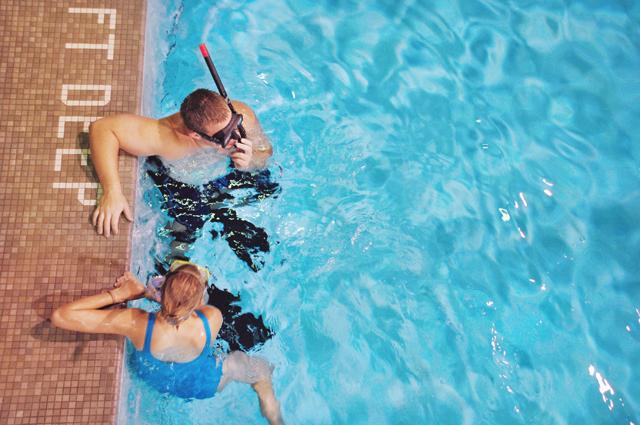
© 2009 NCSU Student Media
For some, running is their thing. For others, it may be Frisbee, soccer, golf or dance. For one particular N.C. State instructor, Matt Rever, SCUBA is what makes him happy.
Rever teaches scuba diving I and II and is NAUI certified, which stands for National Association of Underwater instructors.
Learning how to scuba dive is something that takes behavior modification and time. Skills learned early on in the first few weeks of class, such as how to do different kicks like the scissor, the modified breaststroke and the dolphin, aid the divers in learning how to handle their bodies’ correctly.
A scissor kick is the most destructive way for a diver to move through the water because when diving the goal is to remain neutrally buoyant, or parallel to the bottom, and not disturb visibility. When scissor kicking, the vertical up and down motion disrupts sediment on the bottom, and creates a huge cloud of sand that remains for days after as it takes time to resettle.
This is bad for two reasons. Divers should be respectful of things not their own and disrupting or spoiling the space by kicking up sediment, plants, invertebrates and microorganisms, violates respect, especially in sensitive areas like coral reefs.
It also leaves the site tainted for future divers to come, as visibility will be decreased.
The only time a scissor kick should be used is in a buddy rescue in which both divers kick together to get themselves to safety.
The dolphin kick is like a body roll starting at the head and going through the back to the toes and is extremely efficient in covering distance, not unlike the animal itself.
The modified breast stroke, which is similar to drawing figure eights with your toes, and is less efficient that both the scissor and dolphin in terms of covering distance; however, in scuba diving it is all about slow and controlled movement, which is what the modified breast stroke provides. It is minimal in sediment disturbance, keeping the ecosystem intact and visibility high.
For Erin Morten, a junior in biological archeology, visibility is extremely important, as she will be using her SCUBA certification to dive at shipwrecks.
“A lot of shipwrecks contain cargo and from that I can study what that country’s or civilization’s culture was like,” Morten said. As shipwrecks often go untouched for hundreds of years they become extremely well preserved keeping things like pottery intact.
Tom Nelson, a junior in mechanical engineering said that the main reason he is taking scuba diving is so that he can dive for either hobby or profession.
“Both of my parents do it so this is a good place for me to learn all the basics,” Nelson said.
With his major, Nelson expects that SCUBA will come in handy.
“Hopefully I can do some site surveys for things like tunnels or for parts that I need go and do a ship salvage,” Nelson said.
Like Nelson, Harrison Smith, a sophomore in business management, is taking scuba diving to open up his family experience, as well as to help drive his career.
“My brother is in the Navy and he wanted a diving buddy, so he paid for my gear and I signed up,” Smith said adding he also had career aspirations of his own since he wants to be a Navy Seal.
As earlier mentioned, the skills learned early on build the foundation for more difficult skills such as remaining neutrally buoyant. In being neutrally buoyant a diver must understand Boyle’s Law, body posture, and controlled breathing.
Boyle’s Law states that as pressure increases, volume decreases meaning that the lower a diver goes and pressure increases, the more compressed air inside the BC or buoyancy control becomes making the diver sink faster. The natural option would be to inflate the BC more; however, if the depth gets shallower suddenly the air inside the BC will expand and send the diver shooting towards the surface because the faster it rises the faster the gas increases in volume, meaning buoyancy, and has the potential to severely injure the diver. The condition occurring to divers who surface to fast is called “the bends” or decompression sickness. This is caused from gas leaving the blood stream to fast and creating bubbles. Decompression sickness is a serious problem and either kills its victim or sends them to the decompression chamber to be rehabilitated.
What must be understood is that neutral buoyancy is a delicate balance between air in the BC, posture and breathing. The last two, posture and breathing, are things learned through beginning skills, meaning by the time students get on SCUBA they only have to adjust to the BC factor of neutral buoyancy.
However hard and dangerous SCUBA may seem, it would be amiss to say that its negatives out weigh its positives for it is true that with genuine effort and hard work comes a great reward, like swimming with fishes, seeing ancient ship wrecks, hanging out with family or spear fishing, like Rever does in his spare time. Rever also has found pre-historic megalodon teeth, an extinct shark, in rivers, though he refuses to disclose where.
“What I enjoy most is seeing someone with little or no experience in diving learn something so efficiently that they can do it alone…teaching folks something that I love gives me those warm fuzzies,” Rever said.